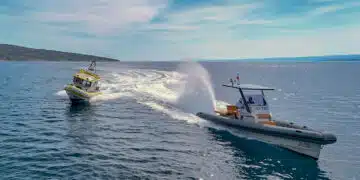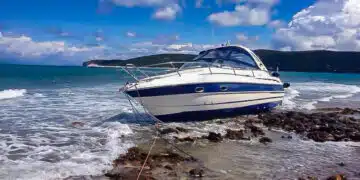Life jackets can help save lives. The problem: in Germany and most EU countries there is no uniformly regulated life jacket obligation. SeaHelp explains when and where in the German-speaking countries and the bordering states there is an obligation to wear a life jacket.
Life jackets can help save lives. Relevant this becomes especially when the water is cold or on the high seas. They are available in many different designs, classes, sizes and colors for sailors, jet skiers, canoeists and SUP fans, and even for Dogs on board appropriate products are offered. The problem: in Germany and most EU countries there is no uniformly regulated life jacket obligation.
Although there are precise regulations in the EU states and in Germany, which life-saving aids on the water as a buoyancy aid, and which are to be designated as a life jacket: decisive for the corresponding classification is a corresponding European standard, which divides buoyancy aids and life jackets into different standard classes. However, there is no uniform EU standard for where and when these must be worn. Accordingly, the uncertainty among water sports enthusiasts is great.
For the EU states, there are definitions of “buoyancy aids” and “life jackets”, but no uniform regulations as to when these are to be worn
Good to know: as buoyancy aids (in vest form) are first classified all those aids that prevent immediate sinking in the event of an accident on the water. These life-saving aids have a buoyancy of 50 Newtons, equivalent to five kilograms. Attention: these aids are not fainting-proof and therefore only suitable for waters where quick help is expected or for experienced swimmers.

lifejackets, on the other hand, are available in various so-called standard classes. These are officially called “performance classes for protection against drowning”. The lowest standard class is category 50 with 50 newtons (or 5 kilograms) of buoyancy force. Standard class 100 is life jackets with 100 newtons of buoyancy force (equivalent to 10 kilograms); recommended for protected areas and inland waters.
The highest standard class for life jackets is 275, recommended for difficult conditions or the high seas.
The next highest standard class is called 150, which are life jackets that are already suitable for all waters, as they are already considered (under certain conditions) to be impregnable. The buoyancy force here is 150 Newtons or 15 kilograms. The highest standard class for life jackets is 275 (275 Newton or 27.5 kilograms of buoyancy force) and is recommended for difficult conditions or the high seas.
In Germany, there is the DIN EN ISO 12402 standard for life jackets; life jackets with a safety belt are covered by DIN EN ISO 12401. For the EU, there is also the so-called Marine Equipment Directive MED 2014/90/EU, this actually applies to marine equipment, but also covers life jackets.
Important to know: Buyers of life jackets should wear on the CE mark when buying, because only then you as a user will also meet the statutory life jacket obligation in the EU member states.
In Germany, you should inform yourself about the state regulations and follow the recommendations of the water sports associations
So far, so good, because: although the definition of “life jackets” is regulated by EU regulations, there is no uniform legal regulation in Germany, which provides information about when, where and under what circumstances a life jacket must be carried or worn. There are only “recommendations” of some water sports interest groups, which state that a life jacket should “always be carried”.
In Germany, the obligation to carry life jackets is generally a matter for the federal states, i.e. each federal state issues its own regulations or makes its own recommendations, which often also relate to specific bodies of water. Only for the shipping lanes and the regulations applicable there, the federal government is responsible (regulations for inland skippers or the transport of goods, not relevant here).
At Lake Constance there is a life jacket carry obligation for motorboats, rowing boats and sailboats
Example Lake Constance: the Lake Constance Navigation Regulations (BSO) requires, for example in Art. 13.20 paragraph 3, that for each person on board with a body weight of 40 kg or more, a life jacket with collar with at least 100 N buoyancy must be carried, valid for “pleasure craft with engine drive”, rowing boats outside the shore zone (except: racing rowing boats) and “sailing craft”. In general, sports skippers are well advised to check with the countries or major water sports organizations in advance.
For Germany (but also in general) applies: even if there is no explicit life jacket obligation, keeping ready or wearing a life jacket can have an impact on insurance coverage. For example, insurance coverage under accident insurance policies may be cancelled if there is no vest on board, because in this case the insurer could accuse the policyholder who has suffered an accident of negligence (argumentation: the damage could have been avoided or prevented if a vest had been carried on board).
Generally, each EU country has its own specific regulations regarding the carrying or wearing of life jackets
Caution: in each country of the EU there are specific regulations. In Austria, for example, the wearing of life jackets or life jackets is not explicitly required, but in the event of an accident, the lack of appropriate safety equipment would be considered a violation of the General Duty of Care (§ 7 Schifffahrtsgesetz, § 1.04 WVO and § 6 SFVO).
In Switzerland (as well as on Lake Constance, see above) there is a “duty to carry” from a distance of more than 300m from the shore. In Italy, SUPers, as well as windsurfers, are obliged to wear life jackets, and also on Lake Garda: life jackets must be worn as soon as you are more than 300 meters from the shore. This applies equally to skippers, stand-up paddlers surfers.
Further examples: in Norway there is since the 2015 a life jacket obligation for occupants of boats with a length up to eight meters (§ 23 SmåbåtlovenI), in Denmark there is a life jacket obligation, but this is not required by law – relevant, however, as already described above, for insurance coverage. In Sweden, life jackets are only mandatory for kayak rentals; there is no general life jacket requirement for water sports enthusiasts.
In France there is likewise no legally standardized, prescribed life jacket obligation, here one should keep however as sport skippers to the minimum and safety equipment recommended by the federations on the respective waters.
Detailed regulations exist for sports boats sailing in Spanish waters
Recreational skippers operating a boat in Spanish waters should be aware of Royal Decree 339/2021, dated May 18, 2021, which regulates, among other things, safety equipment for recreational boats. In Chapter II Rescue Equipment, Article 7 also contains regulations on the obligation to wear life jackets.
According to this, recreational boats must carry at least one life jacket per person on board, supplemented by a life jacket (with light). However, lights may be dispensed with for recreational craft operating in zones 4, 5, 6 or 7 and operating exclusively during the day.
For this purpose, Zone 4 is defined as navigation in the area between the coast and the line parallel thereto at 12 nautical miles; Zone 5: navigation in which the vessel is not more than 5 miles from a shelter or accessible beach; Zone 6: navigation in which the vessel is not more than 2 miles from a shelter or accessible beach; Zone 7: navigation in protected coastal waters, harbors, roads, estuaries, protected bays and protected waters in general.
In addition: recreational boats navigating in Zone 1 (defined as unlimited navigation zone) must wear an additional life jacket. In addition, life jackets must be provided for all children and babies on board according to their weight and size.
For Spain, vests with specific minimum buoyancy are required for each navigation zone.
The minimum buoyancy that the (CE certified) vests must have is in Zone 1 (unlimited navigation) – 275 Newton, in Zones 2. 3. 4 – 150 Newton (where Zone 2 is defined as navigation in the area between the coast and the line parallel to it at 60 nautical miles and Zone 3 is defined as navigation in the area between the coast and the line parallel to it at 25 nautical miles); for Zones 5, 6 and 7 (see above for definition) a minimum buoyancy of the vests of 100 Newton is mandatory.
Finally, recreational boats sailing in zones 1, 2, 3, or 4 must also carry a life preserver with light and line. Furthermore, in Zone 1, an additional life ring must be carried, for which neither light nor lanyard are required.
The scope of this Royal Decree extends to all recreational boats registered in Spain, “carrying out an activity for commercial or lucrative purposes in maritime waters where Spain exercises sovereignty, sovereign rights or jurisdiction, regardless of its flag state, in accordance with the legislation in force,” or that “sail (in) the internal maritime waters of Spain or the Spanish territorial sea, regardless of their flag state.”
Croatia boating holidaymakers are subject to a life jacket requirement for fast boats
The following applies to Croatia:All persons on boats that exceed 20 knots must wear life jackets while sailing, unless they are indoors. In case of doubt here: this regulation applies to boats that can go 20 knots (about 37 km/h) fast (technically possible maximum speed) and to boats with which you are actually traveling at this speed.
The life jacket obligation should therefore apply even if, for example, you are traveling at only 10 knots (18.5 km/h) on a jet ski that can theoretically travel at 20 knots or more. In Spain, on the other hand, the wearing of life jackets is mandatory by law, regardless of whether coastal or inland waters or smaller lakes are involved. However, in Croatia this regulation only applies to boats sailing under the Croatian flag.













